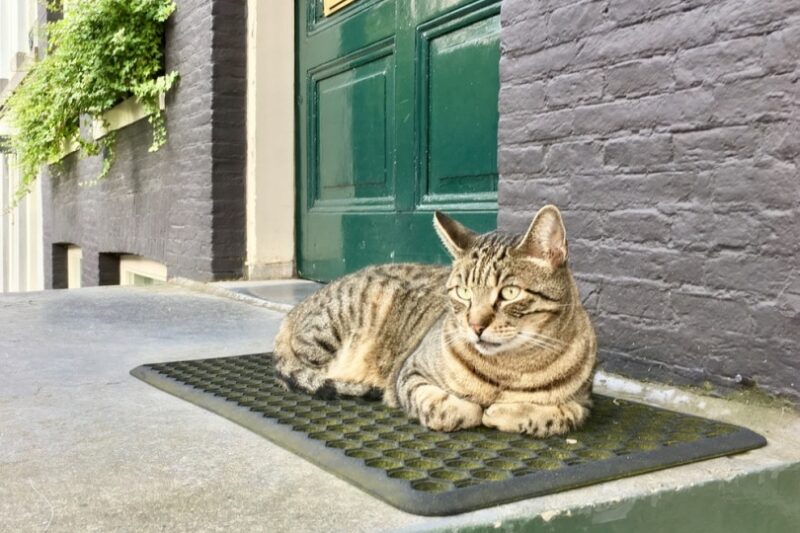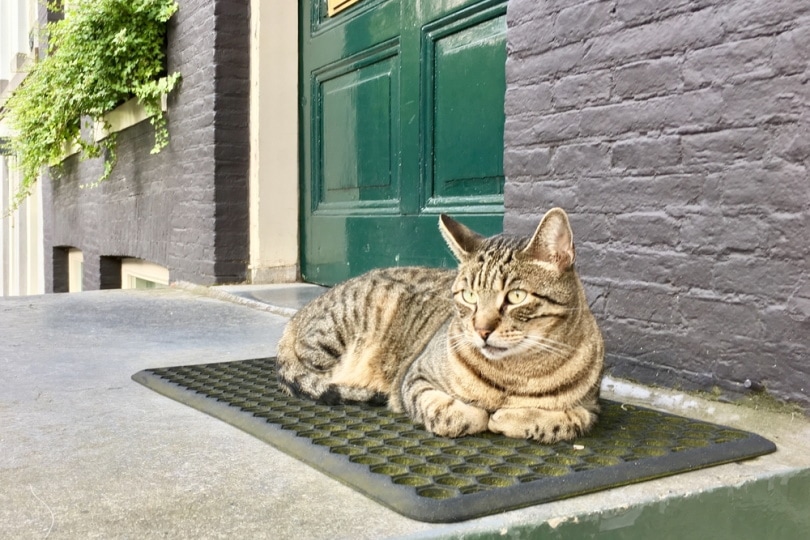
That’s where heating pads come in. For outdoor use, you need a heating pad that can withstand elements such as moisture and wind without jeopardizing the safety of your cat.
There are so many options available, with different features to choose from. We’ve gathered the best ones and provided reviews below.
A Quick Comparison of Our Favorites of 2024
| Image | Product | Details | ||
|---|---|---|---|---|
| Best Overall |
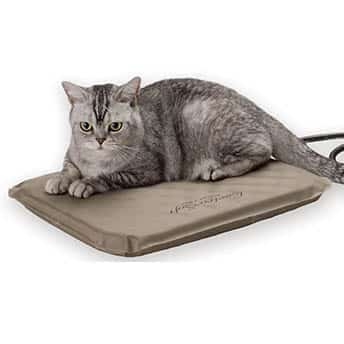
|
K&H Lectro-Soft Heated Pad |
|
CHECK PRICE |
| Best Value |
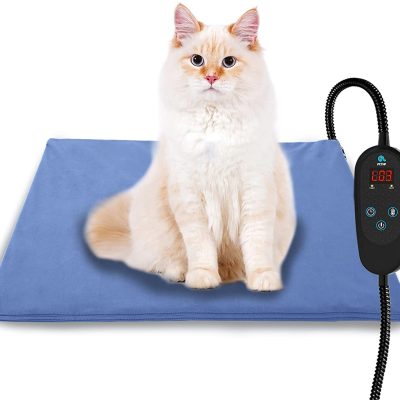
|
PetNF Waterproof Heating Pad |
|
CHECK PRICE |
| Premium Choice |

|
K&H Lectro-Soft Outdoor Heated Bed |
|
CHECK PRICE |
| Best for Kittens |

|
K&H Small Animal Heating Pad |
|
CHECK PRICE |
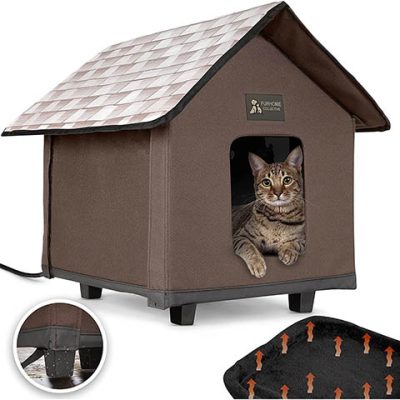
|
FurHome Heated Cat House & Pad |
|
CHECK PRICE |
The 7 Best Outdoor Heating Pads for Cats
1. K&H Lectro-Soft Outdoor Heated Pad – Best Overall
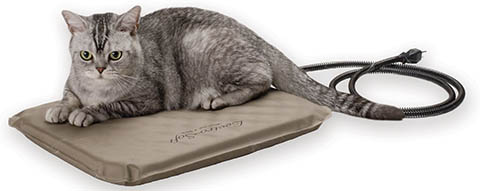
| Materials: | Fleece and PVC |
| Machine-Washable Cover: | Yes |
| Plug-In: | Yes |
Our top pick for the best outdoor heating pad for cats is the K&H Lectro-Soft Outdoor Heated Pad. This heating pad features a foam pad covered in water-resistant PVC, which is then covered in fleece so that your cat stays comfortable and cozy. The fleece cover can also be removed and washed in the washing machine. The K & H heating pad is designed to be used outdoors, but it can be used indoors as well. It can make a great addition to your porch or garage, so your cat can stay dry and warm.
The power cord is 5½ feet long, and you should be able to reach any outdoor power outlet. This heating pad works by warming your cat to their normal body temperature. It also comes in small, medium, and large sizes to accommodate any size cat (or even a dog). However, it is not recommended to use with young kittens who cannot remove themselves from the pad once they have warmed up.
- Features a removable, machine-washable cover
- Water-resistant
- Comes in three different sizes
- Shouldn’t be used with small kittens
2. PetNF Waterproof Heating Pad with Timer – Best Value
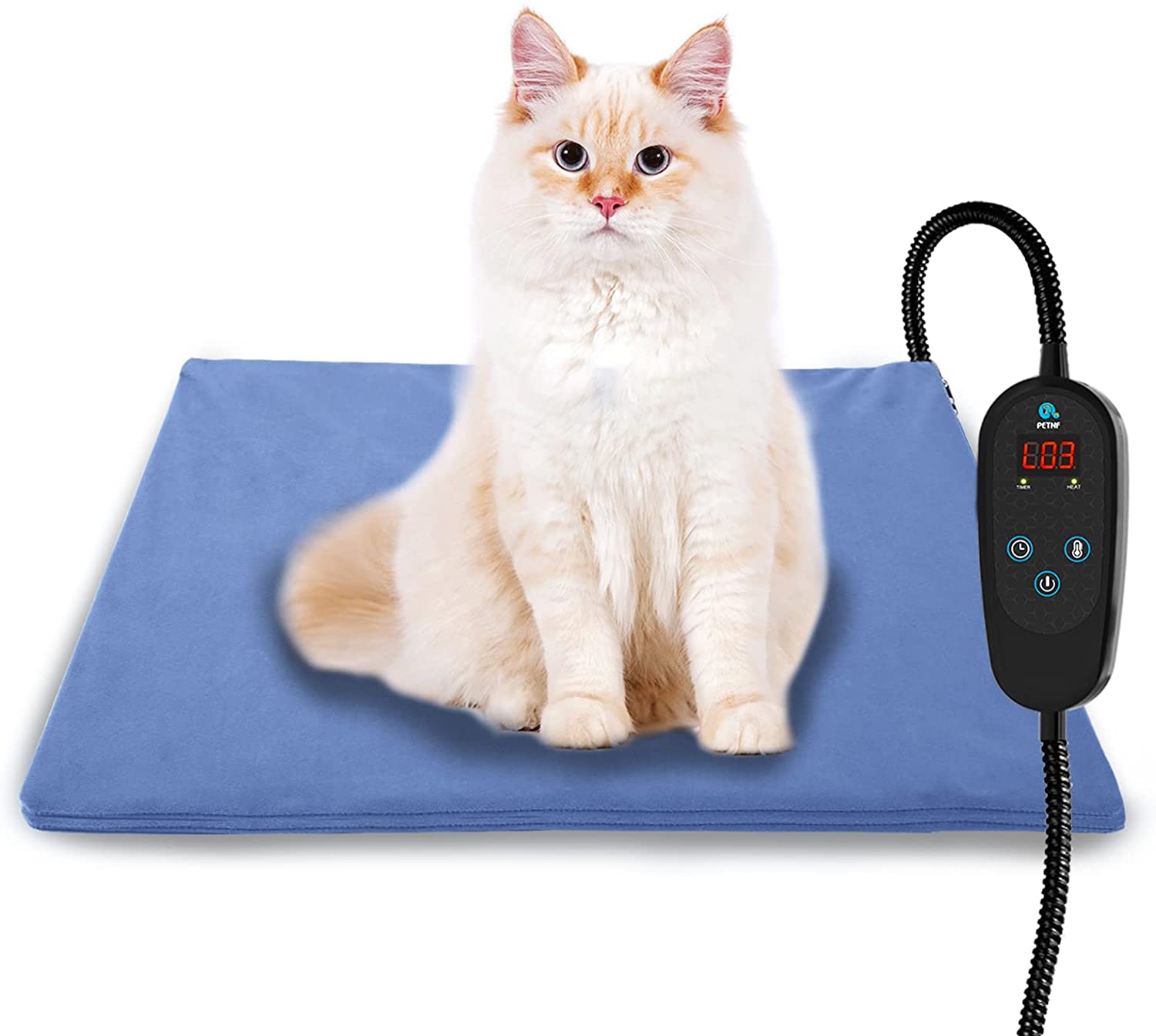
| Materials: | Fleece and PVC |
| Machine-Washable Cover: | Yes |
| Plug-In: | Yes |
The best outdoor heating pad for the money is the PetNF Heating Pad with Timer. Not only is the PVC foam enclosure waterproof, but it’s flame retardant as well, so you can feel secure knowing that your pet is 100% safe. The outer cover is made of fleece and can be removed to be washed in the washing machine.
Plus, the PVC can be wiped clean as well if needed. This heating pad also has an adjustable temperature feature with six temperature levels and a timer to prevent your pet from overheating.
The power cord on this heating pad is almost 7 feet long and is chew-resistant to keep your pet from getting hurt. It comes in three sizes: the medium size is good for one cat, but the large size is big enough to accommodate multiple cats.
The downside is that due to the timer and control device, the pad shouldn’t be immersed in water, so you need to use it in a covered area such as a barn or screened-in porch that will keep water out.
- Big enough for multiple cats
- Features 6 different temperature
- Has a timer
- Needs to be used in a covered area
3. K&H Deluxe Outdoor Heated Bed – Premium Choice
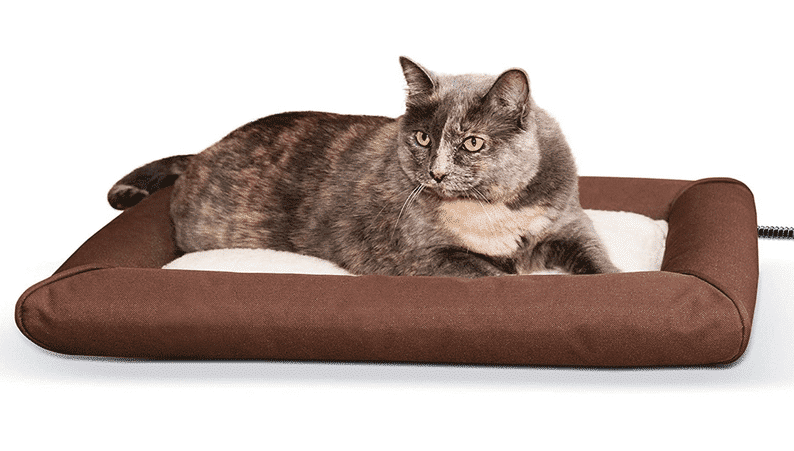
| Materials: | Fleece and polyfill |
| Machine-Washable Cover: | Yes |
| Plug-In: | Yes |
This K&H Outdoor Heating Pad for cats isn’t just a heating pad; it’s a whole bed. This heated bed features four bolster pillows to provide your pet with the ultimate comfort and a place to lay where their neck can be supported. The pillows and heating pad also feature a removable fleece cover for easy cleaning. It comes in three sizes, which is ideal if you have multiple cats.
This heating pad also has a 5½ foot-long, steel-wrapped cord, and it is chew-resistant and safe for outdoor use. The pillows are filled with polyfill material for superior comfort for your pet. However, it may not be as waterproof as a heating pad made with PVC, and it is a good idea to use this bed in a covered area. Another downside is the high price, but that’s why this bed is a premium choice.
- A bed instead of just a pad
- Removable fleece cover
- Can be used for multiple cats
- Pricey
- May not be as waterproof as other pads
4. K&H Small Animal Heating Pad – Best for Kittens
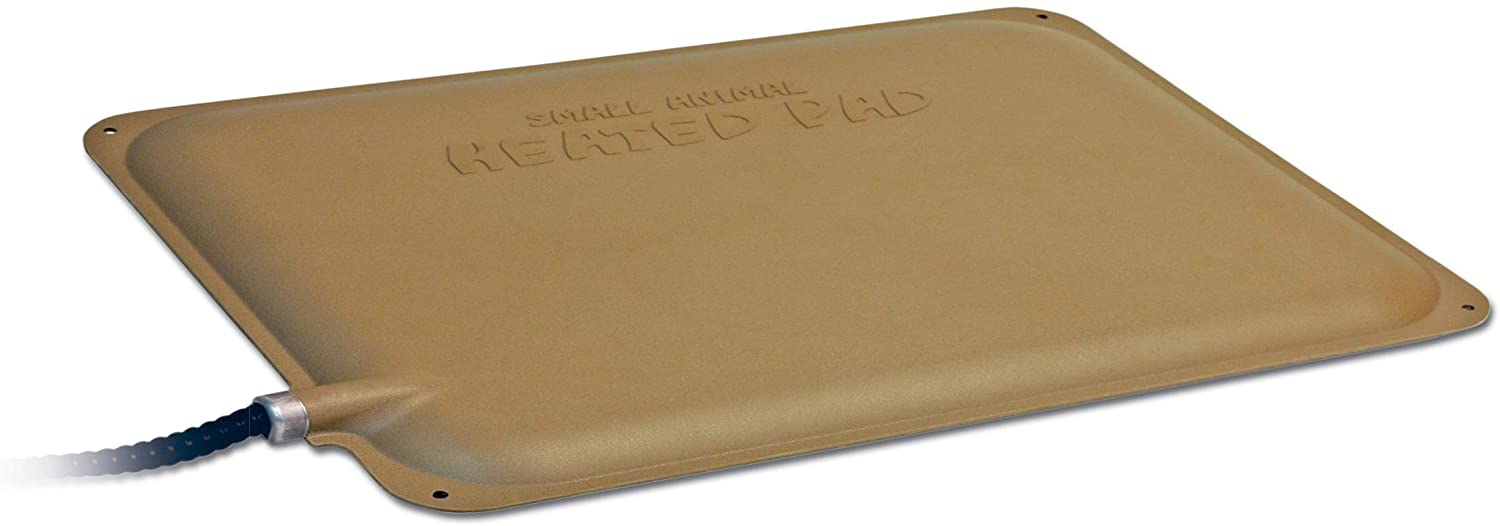
| Materials: | PVC |
| Machine-Washable Cover: | No |
| Plug-In: | Yes |
The K&H Small Animal Heating Pad is marketed for small animals such as rabbits and ferrets, but it can work for kittens as well. It can be used indoors or outdoors, so you can keep your kittens indoors and keep them warm until they are big enough to go outside.
It also doesn’t get as hot as heating pads designed for adult cats, so you won’t have to worry about your kitten getting burned or overheating. A hole in each corner allows you to use screws to secure the heating pad to a wooden porch so that it doesn’t get moved around.
This heating pad doesn’t have a removable cover, so it may not be as soft or comfortable for a kitten. However, you could put a blanket on top to make it more comfortable and still be able to feel the heat underneath. Plus, the PVC material is waterproof and can be easily wiped clean. Another downside is that this heating pad is only 9” x 12”, so it is only big enough for one kitten and not a whole litter.
- Designed for small animals
- Doesn’t get as hot as larger heating pads
- Can be mounted to wood surfaces
- Doesn’t have a removable cover
- Only big enough for one kitten
5. FurHome Collective Elevated Heated Cat House w/ Heating Pad
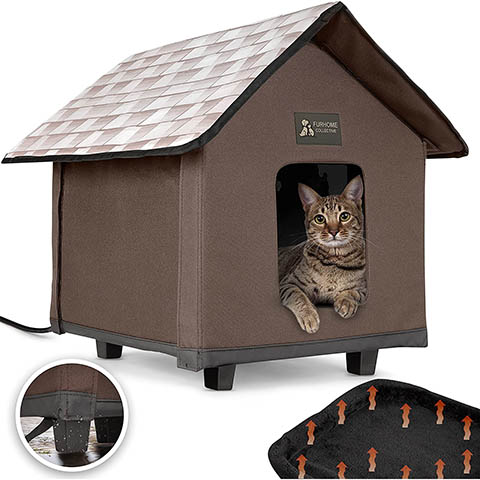
| Materials: | Waterproof fabric, PVC, and foam |
| Machine-Washable Cover: | Yes |
| Plug-In: | Yes |
The FurHome Collective Elevated Heated Cat House w/ Heating Pad features a removable heating pad, and you can use them together or by themselves. The heating pad is covered in a faux fur fabric cover that can be removed and washed. The house is made from a waterproof fabric and is elevated so it doesn’t sit on the cold ground. This will help keep some of the warmth inside the house. It also features two doors with PVC flaps that keep heat in as well.
Additional features of this cat house include a timer and chew-proof cord. You can choose from two colors: chocolate and beige. Even though the cat house is described as waterproof, the description says not to leave it directly outside in the rain and snow.
Customers who have bought this cat house also describe it as flimsy, suggesting it may blow away in a strong wind or storm. However, it has buckles with holes that can be secured to the ground.
- The house provides extra protection
- The heating pad is removable
- Elevation and door flaps keep the heat in
- May not be completely waterproof
- Some owners describe it as being flimsy
6. Outdoor Heated Kitty House with Removable Heating Pad

| Materials: | Nylon and vinyl |
| Machine-Washable Cover: | Yes |
| Plug-In: | Yes |
The Outdoor Heated Kitty House w/ Removable Heating Pad also contains a removable heating pad so that you can use the house and the heating pad at once or separately. The roof of the house is removable so that you can easily remove the heating pad and clean the house if necessary.
The house is made from durable nylon and vinyl, while the heating pad has a removable fleece cover so that it can be washed. It’s easy to assemble, and all you need to do is Velcro the walls together. However, this method raises questions about the sturdiness of the house and how the Velcro will hold up over time.
Other features of this cat house include two exits with removable door flaps, as well as an electrical cord that’s safe for outdoor use. While the cord is safety-rated, it is not designated as being chew-proof. That shouldn’t be a problem unless you have a cat that likes to nibble. The house isn’t elevated, so you want to put it outdoors where the bottom can stay dry. The house is large enough to accommodate two cats, and it comes in seven colors and styles.
- Easy to assemble and remove the heating pad
- Made from durable materials
- Big enough for two cats
- Velcro may not hold up over time
- The cord isn’t chew-proof
- The house isn’t elevated
7. K&H Extreme Weather Outdoor Kitty Pad
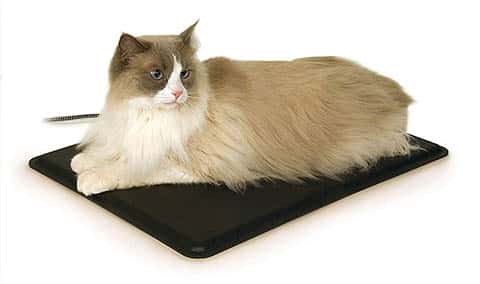
| Materials: | ABS plastic and fleece |
| Machine-Washable Cover: | Yes |
| Plug-In: | Yes |
The Extreme Weather Outdoor Kitty Pad is made of durable ABS plastic, which is stronger than PVC. However, that seems to be the only difference between the “extreme weather” version and the regular version of this heating pad. The name of this kitty pad sounds like it would offer better protection for your pet against extreme weather, but it doesn’t get any warmer or more waterproof than other outdoor heating pads. However, you can put it inside a cat house for added protection.
Although it isn’t shown in the picture, this heating pad has a fleece cover that can be removed and washed in the washing machine. However, it is just a cover, which wraps around the pad with elastic straps, so it may not be the most secure.
You can buy the deluxe cover to fit the heating pad, but it costs more. The cord is chew-proof and long enough to reach an outlet inside a garage or on a porch. It isn’t big enough to accommodate more than one cat, but it is a great option if you only have one cat.
- More durable than other heating pads
- Chew-proof cord
- Comes with a free fleece cover
- Provides no better protection than other heating pads
- The fleece cover may not be secure
- Not big enough for multiple cats
Buyer’s Guide: Selecting The Best Outdoor Heating Pad for Cats
Now that you’ve had the opportunity to compare several heating pads and their features, it may seem overwhelming when deciding which one to choose. That’s why we’ve also provided this buyer’s guide so that you know which features are essential and which are just a nice bonus.
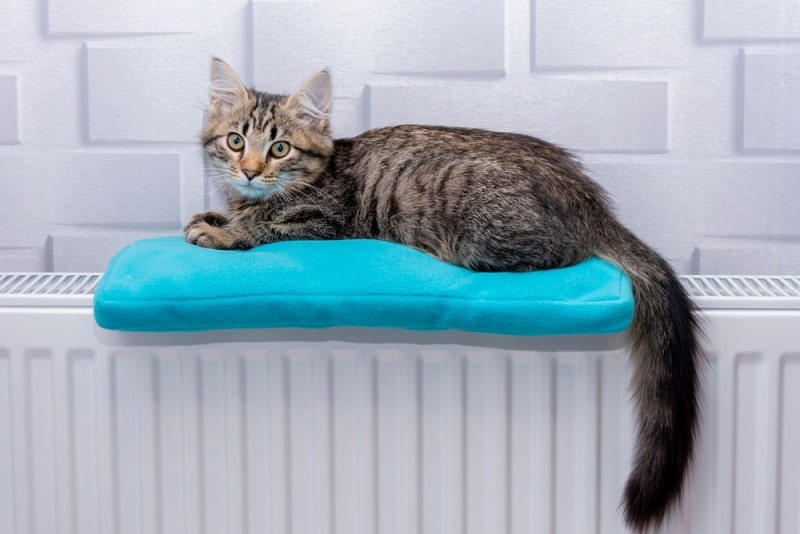
Ensure the Heating Pad Can Be Used Outdoors
When choosing a heating pad that you intend to use outdoors, one of the most important things you should do is make sure that the heating pad specifies that it is for outdoor use. This is important because outdoor heating pads are designed to be waterproof and durable, as well as have electrical cords that are reinforced so that they are safe to use outdoors.
All of the heating pads that we reviewed in this guide specify either in the name or the description that they can be used outdoors. You don’t want to replace your heating pad due to water. What’s worse is that using a heating pad designed for indoor use outdoors can put you and your pet at risk for electrical shock. Remember, it’s okay to use an outdoor heating pad indoors, but it’s not a good idea to use an indoor heating pad outdoors.
Temperature Control
Another factor you’ll need to consider is whether you want to be able to control the temperature that the heating pad puts out. Most of the heating pads have self-adjusting thermostats, but one or two of them have different temperature settings you can choose from.
An example of when you may want to control the temperature is when you have a kitten or a sick pet needing more or less heat. Of course, you should always check with your vet before using a heating pad on a pregnant or sick cat.
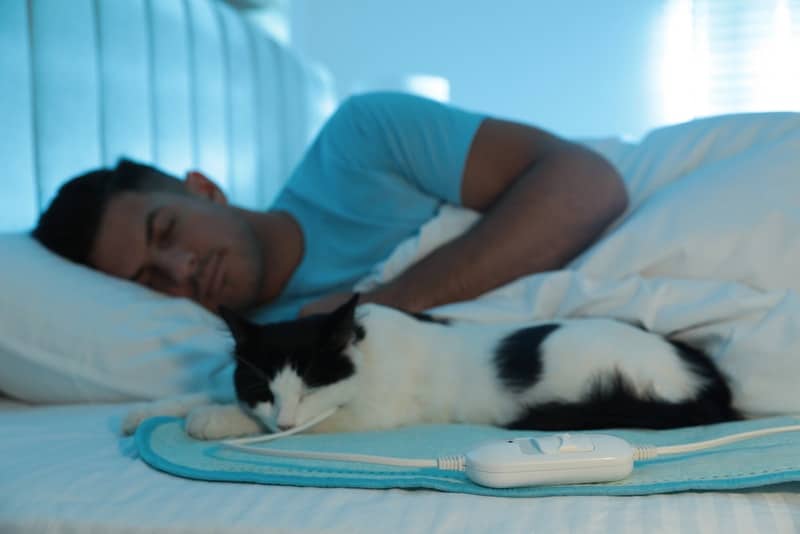
Timer or No Timer
You’ll also want to consider whether or not you want the heating pad to have a timer. Most heating pads with self-adjusting thermostats don’t need a timer. However, some heating pads have timers to save energy or limit how long the pad stays warm. Heating pads with timers can keep your cat from laying on them for too long.
Removable Cover
A heating pad with a cover is more comfortable for your cat because it provides a soft surface for them to lie on. If you choose to go with a heating pad with a cover, it’s best if the cover is removable so that you can wash it to remove cat hair, dander, and dirt. Even if you don’t go with one that has a cover, you can place a blanket on top of the heating pad to make it more comfortable for your cat.
Heated Houses
Outdoor cat houses provide more protection from the elements, and heated versions usually contain a heating pad to help your cat stay warm. Ideally, the heating pad should be removable so that you can clean it. You’ll also want to make sure that your cat doesn’t have a hard time getting out of the house.
Otherwise, they could get hurt by the heating pad. It’s also worth noting that if you have a covered porch or a garage where your cat stays, a cat house probably isn’t necessary.
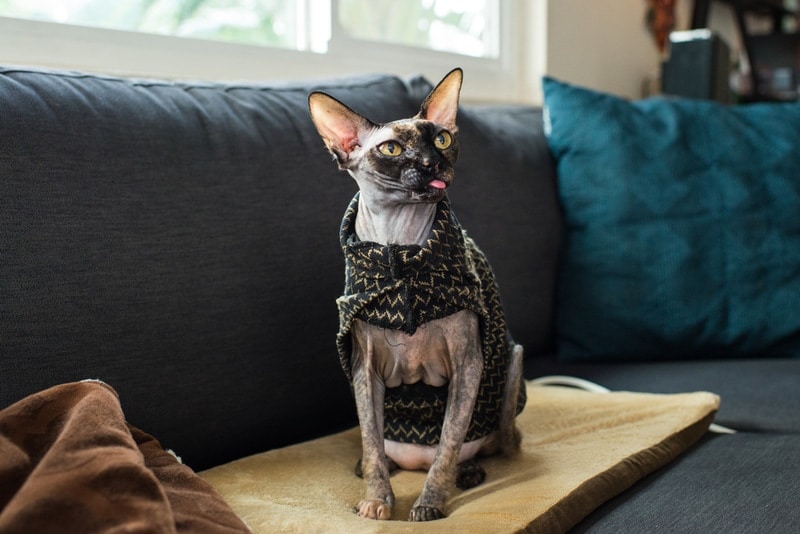
One or Multiple Cats
Finally, you’ll need to consider how many cats you have that stay outdoors. Heating pads come in different sizes, and you want to ensure that you buy one large enough for all of your cats to use if you don’t want to buy separate ones. Larger heating pads are designed to be used by dogs, but they can easily accommodate two, three, or even four cats, depending on how large they are.
Conclusion
Heating pads are a great way to keep outdoor cats warm, especially in rainy or cold conditions. Hopefully, our reviews and buyer’s guide helped make your decision easier. You’ll want to choose a heating pad designed for outdoor use, but other features are up to you. We like the K&H Lectro-Soft Outdoor Heated Pad as the best overall due to all of the features it has. For a budget-friendly option, the PetNF Heating Pad with Timer is the ideal choice.
Featured Image Credit: jax10289, Shutterstock
Contents
- A Quick Comparison of Our Favorites of 2024
- The 7 Best Outdoor Heating Pads for Cats
- 1. K&H Lectro-Soft Outdoor Heated Pad – Best Overall
- 2. PetNF Waterproof Heating Pad with Timer – Best Value
- 3. K&H Deluxe Outdoor Heated Bed – Premium Choice
- 4. K&H Small Animal Heating Pad – Best for Kittens
- 5. FurHome Collective Elevated Heated Cat House w/ Heating Pad
- 6. Outdoor Heated Kitty House with Removable Heating Pad
- 7. K&H Extreme Weather Outdoor Kitty Pad
- Buyer’s Guide: Selecting The Best Outdoor Heating Pad for Cats
- Ensure the Heating Pad Can Be Used Outdoors
- Temperature Control
- Timer or No Timer
- Removable Cover
- Heated Houses
- One or Multiple Cats
- Conclusion

